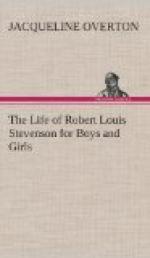“‘Out with you—out of the door!’ she screeched.
“I do not know how it happened, but the next moment we were out in the rain and darkness. This was not the first time that I have been refused a lodging. Often and often I have planned what I would do if such a misadventure happened to me again, and nothing is easier to plan. But to put in execution, with a heart boiling at the indignity? Try it, try it only once, and tell me what you did.”
Frequently on this trip the Arethusa’s odd dress and foreign looks led him to be taken for a spy. It was not long after the Franco-Prussian war, and all sorts of rumors of suspicious characters were afloat. Once he was actually arrested and thrown into a dungeon because he could show no passport, and the commissary refused to believe he was English and puzzled his head over the scraps of notes and verses found in his knapsack.
He was rescued by the faithful Cigarette, who finally convinced the officials that they were British gentlemen travelling in this odd way for pleasure, and the things in his friend’s bag were not plans against the government, but merely scraps of poetry and notes on their travels that he liked to amuse himself by making as they went along. [Footnote: This incident is told in the “Epilogue to An Inland Voyage.”]
The canoe trips ended in a visit to the artists’ colony at Fontainebleau, where Bob Stevenson and a brother of Sir Walter’s were spending their summer. This place always had a particular attraction for Louis and he spent many weeks both there and at Grez near by during the next few years.
The free and easy life led by the artists suited him exactly, although he found it hard to accomplish any work of his own, but dreamed and planned all sorts of essays, verses, and tales which he never wrote, while the others put their pictures on canvas.
“I kept always two books in my pocket,” he says, “one to read and one to write in. As I walked my mind was busy fitting what I saw with appropriate words; when I sat by the roadside I would either read, or a pencil and penny version-book would be in my hand, to note down the features of the scene or commemorate some halting stanzas. Thus I lived with words.”
If there was little work, to show after a stop at Fontainebleau he had many memories of good-fellowship and some of the friends he met there were to be the first to greet him when he came to live on this side of the water.
While on their “Inland Voyage” the two canoemen had decided that the most perfect mode of travel was by canal-boat. What could be more delightful? “The chimney smokes for dinner as you go along; the banks of the canal slowly unroll their scenery to contemplative eyes; the barge floats by great forests and through great cities with their public buildings and their lamps at night; and for the bargee, in his floating home, ‘travelling abed,’ it is merely as if he were listening to another man’s story or turning the leaves of a picture book in which he had no concern. He may take his afternoon walk in some foreign country on the banks of the canal, and then come home to dinner at his own fireside.”




